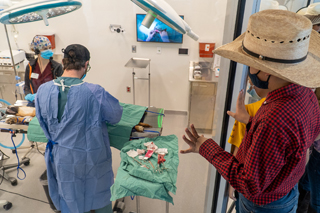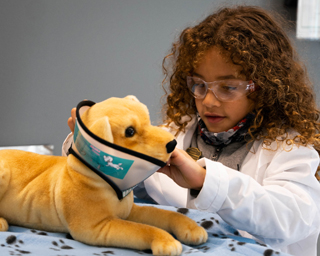CSUSpur_watching_surgery_2

Photo courtesy the CSU System
Youngsters watched as a dog was neutered last month at the Colorado State University System's new campus in north Denver. Witnessing veterinarians at work is just one of several animal health experiences available to the public at CSU's recently opened Vida building.
 Listen to this story.
Listen to this story.
A 9-foot-tall white plastic cat sits in the light-filled entrance of the Vida building at Colorado State University's new campus in north Denver. Approach the cat straight on, and it meows or purrs. Circle around and walk toward its tail, and the cat lets out an intimidating hiss or a low growl like a tiger.
The interactive feline communicates a clear message: There are good and not-so-good ways to greet a cat. It's the first of hundreds of lessons to be learned at CSU's public education facility, which opened in January.
Focusing on animal and human health, Vida (which means "life" in Spanish) is one of three buildings at CSU Spur, the name of the complex on the grounds of the new National Western Center. The other two buildings — Hydro and Terra, focusing on water and agriculture, respectively — are under construction and slated to open before the end of the year. The campus is free and open to the public, with the primary aim of exciting students in grades K-12 about careers in science, technology, engineering and math.
"CSU is a land-grant institution; access is part of what we do," explained Tiana Kennedy, assistant vice chancellor of external relations at the CSU System, which is made up of CSU Fort Collins, CSU Pueblo and CSU Global. "[We] can bring in all sorts of kids who have never been exposed to something like this."
The university is one of several entities, including the Denver Museum of Nature & Science and History Colorado, partnering with the National Western Stock Show to redevelop the livestock event facilities into a year-round destination. In 2015, the state legislature gave $250 million to the CSU System for CSU Spur and related improvements at the main campus in Fort Collins, about 60 miles north of the city.
The centerpiece of Vida is a working hospital focused on providing access to veterinary care for underserved communities, clinical training for students at CSU's College of Veterinary Medicine and Biomedical Sciences and unprecedented opportunities for the public to watch veterinarians at work.
A few paces beyond the big noisy cat is a spot for a placard that will warn when necessary: "CAUTION! You are now entering the active animal hospital. Surgeries are underway; you are likely to see blood. Guest discretion is advised."
Several benches and tiered steps overlook five picture windows. On most weekdays, the fully equipped surgery and dental suites and examination rooms will bustle with action. These are a public-facing part of a larger hospital run by the Dumb Friends League, a nonprofit humane society offering shelter, adoption, education and veterinary services. The name refers to animals that cannot speak for themselves. The CSU Spur facility is the organization's second community veterinary hospital in Denver.
On Jan. 7, when the building opened to coincide with the 16-day livestock show, veterinary teams performed spay and neuter surgeries on shelter animals in public view. This week, they began giving a wider range of care to owned pets.
Members of the veterinary team wear microphones and narrate procedures as they work. Digital cameras installed on treatment-room lights relay video, including close-up views of incisions, to screens mounted above the observation windows. An educator stands with the audience to provide context and relay their questions to the veterinary team.
Drs. Nicole Kizer and Renee Staffeld, associate veterinarians for the Dumb Friends League, will be working at Spur regularly and were there from the beginning. They admit they weren't sure how the audience would take things. To their relief, everyone seemed engaged – especially children.
"They had their faces up against the glass ... trying to see in more detail," Kizer said. "There were a couple kids who were really interested, and I had some testicles in my hands. I was like, 'Do you want to see them?' and they were like, 'Yeah.' So, I showed them against the glass. I could see them mouthing, 'That's so cool!' "
Performing familiar surgeries eased the adjustment to working in front of an audience, but that doesn't mean everything went predictably.
Early into an operation on a cat, Staffeld discovered it had already been spayed. "That was a great opportunity to educate people about why we tattoo, because when a little cat is spayed, it can be very difficult to see a scar," she said. "I had to take the bladder out and look underneath and show how we confirm that an animal is, in fact, spayed. People were really interested in that."
CSUSpur_VidaExterior

Photo courtesy of CSU System
Vida, a public education facility focusing on animal and human health, opened Jan. 7 on the CSU Spur campus in north Denver. It is the first of three buildings that aim to inspire young people to consider careers in health, water and agriculture.
She also had a stressful experience spaying an old, obese dog. "It wasn't going smoothly, everything was … falling through my fingers, and there was more blood than I would really want," Staffeld said. "I think some people did get a little, 'I don't want to do this,' which is fine, totally."
The case offered a compelling example of why neutering is better done on younger animals.
Over time, the veterinarians are likely to perform an array of procedures, including removing foreign objects, amputating limbs, excising tumors, removing eyes (enucleations) and exploratory surgery. Behind the on-view treatment areas is a full hospital not on display. Pet owners may choose to have their animal treated out of the public eye.
The Dumb Friends League will also operate a high-volume spay/neuter clinic for feral and owned cats on the second floor of Vida. Like on the first floor, the procedures will be viewable by the public.
Full circle
Kizer remembers as an 8-year-old watching surgery on a horse during an open house at a veterinary school. "That's one of the big things that inspired me to become a veterinarian," she said. "I feel like now I can come full circle and inspire future generations, and that's really exciting to me."
CSUSpur_examroom_2

Photo courtesy of CSU System
Children can try on the role of veterinarian in mock exam rooms at Vida.
While kids may be a key audience, the veterinarians said reaching adults is valuable, too.
"To me, the huge benefit is educating why what we do matters," Staffeld said, noting that one challenge in veterinary practice is persuading owners to carry out treatment plans faithfully. "I think being able to see what we do … will hopefully increase compliance, as well."
Kizer agreed, adding that some depictions of veterinarians in popular culture create false impressions of subpar care. "Here, they can actually see we're using the same anesthesia machine, we're using the same equipment, we're using the same medications and level of intensive monitoring that we would want for any human patient," she said.
As far as the Dumb Friends League and CSU representatives know, Vida is the first place in the U.S. to invite the public to watch veterinary care for companion animals. The Denver Zoo and the Animal Kingdom theme park at Walt Disney World offer the public a chance to observe veterinary care of captive wild animals.
The connection to Disney isn't accidental. CSU's Kennedy said the idea for creating on-view areas came from Dr. Mark Stetter, former dean of the veterinary school. "He used to work for Disney and … he thought, 'Why can't we do this for dogs and cats?' " (In October, Stetter left CSU to become dean at the University of California, Davis, School of Veterinary Medicine.)
CSU Spur is owned by the CSU System. The hospital equipment belongs to the Dumb Friends League.
The future veterinarian is in
CSUSpur_Underwater_treadmill

Photo courtesy of CSU System
A horse helped to demonstrate the underwater treadmill last month at the CSU Equine Sports Medicine Clinic, also housed at CSU Spur.
Throughout the building, displays – many of them interactive and a few using virtual reality – drive home messages about animal health careers, the human-animal bond and animal behavior. On the first floor are five replica consultation rooms, each equipped with kid-friendly versions of veterinary tools and exam tables with a toy patient.
Kim Davis, an interior designer who lives in West Denver, brought her children for opening day at the invitation of her friend Kennedy, the CSU assistant vice chancellor. Davis said her daughter, Wynn, 5, wants to be a veterinarian, and son, Grey, 7, wants to work at a zoo and is currently infatuated with penguins.
They quickly settled into one of the mock consultation rooms, where Wynn took the lead in examining a stuffed calico. "We spent almost an hour exploring every nook of the office area," Davis recounted by email. "From the veterinary lab coats to clipboards with checkup checklists, to the X-ray displays, to the cat carriers — it was so detailed, and they loved every part of it!"
There were no surgeries going on when they visited, but Davis showed her children the operating theater. "Honestly, at first, I was a bit shocked to hear there would be LIVE surgeries," she said, "but I immediately thought of what a cool experience that would be for my kids to get to witness and experience."
CSU Spur also houses satellite locations of the CSU Temple Grandin Equine Center, where human patients with conditions such as autism, cerebral palsy and post-traumatic stress disorder receive therapies involving horses; and the CSU Equine Sports Medicine Clinic. (The primary locations of each center are in Fort Collins.) As with the companion animal hospital, the public is allowed to watch the equine activities, potentially inspiring visitors to consider other possible careers in animal and human health.